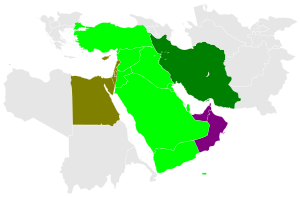
▉▉▉ Standard time observed all year
▉ Daylight saving time observed
Time in Syria is given by Arabia Standard Time (AST) (UTC+03:00).
On October 4, 2022, Syria abolished daylight saving time (DST). [1] Prior to that date, Syria used EET (UTC+02:00) and observed DST, as EEST (UTC+03:00). Transition dates had in general been last Friday of March (sometimes first Friday of April) to last Friday of October, or before 2006 1 April to 1 October with variations. [2] This was similar, but not same as the European Union, where transition dates are on Sundays.